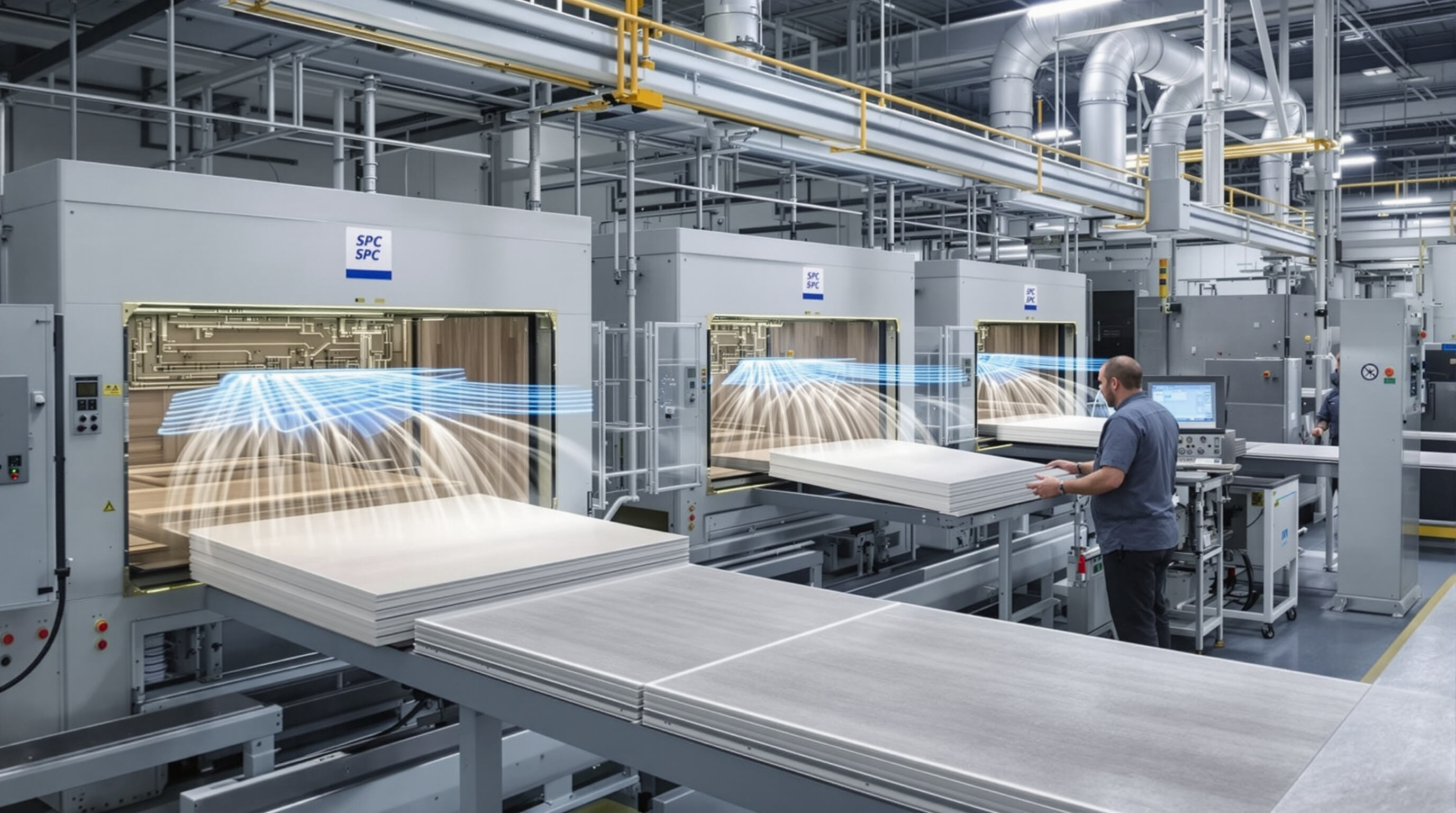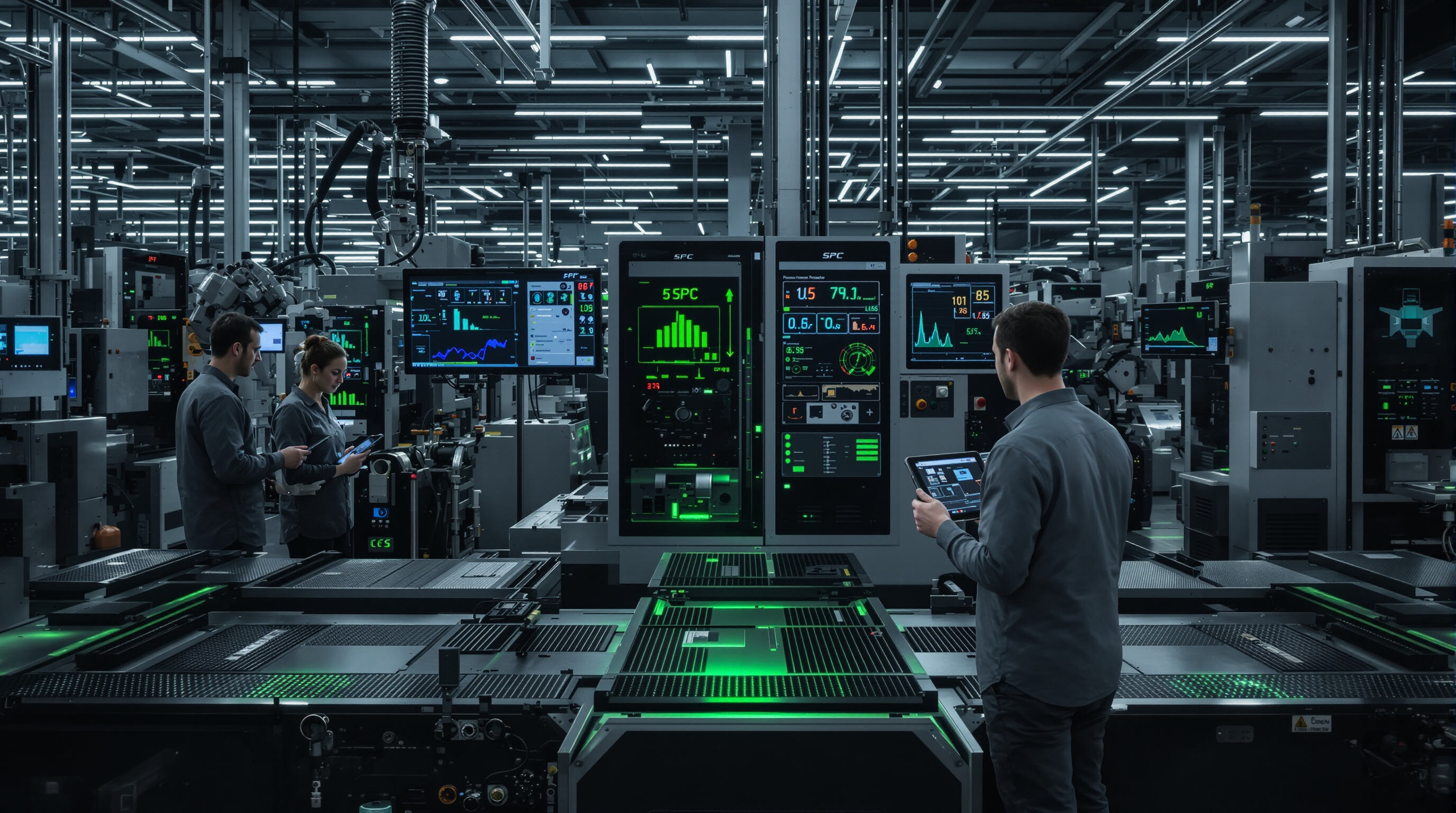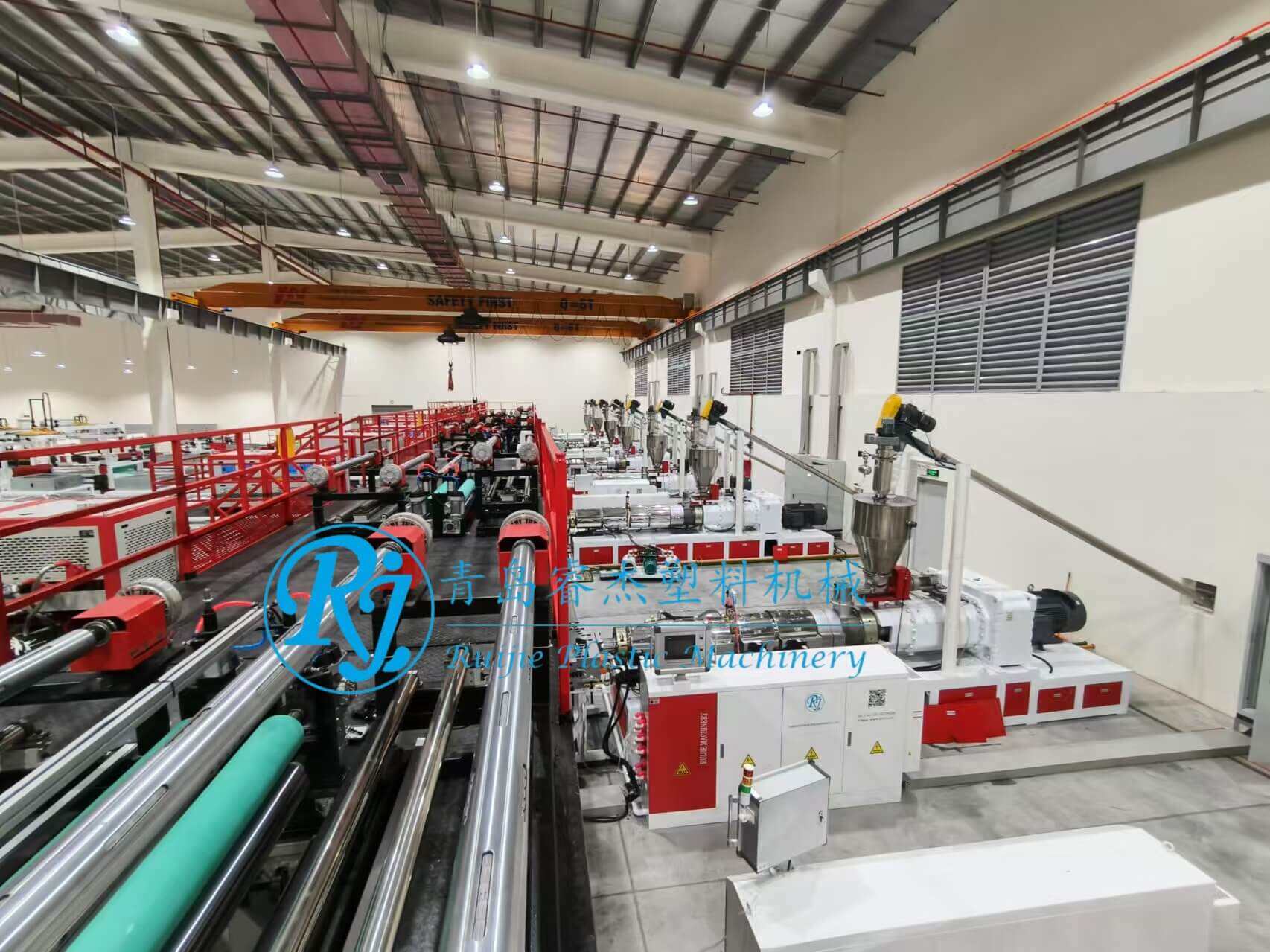Förståelse SPC-golvmaskiner och kärnproduktionsteknologi
Vad är SPC-golvmaskiner och hur fungerar de?
SPC-golvmaskiner, även kända som Stone Plastic Composite-system, fungerar som automatiserade fabriker för tillverkning av hårdgolvsplattor. De blandar PVC-har, kalciumkarbonat samt olika stabiliseringsmedel under en temperaturkontrollerad tillverkningsprocess. Dessa produktionslinjer arbetar vanligtvis vid temperaturer mellan 175 och 190 grader Celsius, vilket hjälper alla material att binda ordentligt utan att lagren separeras senare. Den nyare utrustningsgenerationn kan faktiskt röra sig med över 25 meter per minut, så producenterna kan snabbt tillverka stora kvantiteter stabila, dimensionellt konstanta golvsplattor som entreprenörer gillar att arbeta med på arbetsplatser i hela landet.
Kemponenter i en modern Produktionslinje för SPC-golv
En högpresterande SPC-golvmaskin integrerar flera precisionsdelar:
- Blandningssystem : Automatiska doseringsenheter med en mätgenauhet på ±0,5%
- Tvillingextruder : Leverera homogen blandning av sammansättningar och exakt tryckreglering
- Kalanderverk : Använd flerlagerskomprimering för att förbättra strukturell stabilitet
- Laserstyrda skärare : Upprätthåll panelens dimensionsprecision inom ±0,2 mm
- Automatiska staplare : Minskar manuellt hanterande med 60 % jämfört med traditionella system
Extrusionsteknikens roll i SPC-golvmaskiner
Extrusionskvalitet hänger på tre kritiska parametrar:
- Temperaturreglering : Säkerställer optimal viscositet för konsekvent lagerfogning
- Skruvhastighet : Justerbara RPM-inställningar (15–45) anpassar sig till olika materialdensiteter
-
Tryckreglering : Upprätthåller enhetlig tjocklek över panelbredder på 1220–1830 mm
Avancerade system använder termisk övervakning i realtid för att förhindra buckling – en ledande orsak till produktionsförluster som kostar tillverkare i genomsnitt 740 000 USD per år (Ponemon 2023).
Exakt kalibrering för konsekvent plattjocklek
Laserstyrda kalibreringssystem möjliggör en tjockleksnoggrannhet på ±0,05 mm, vilket eliminerar ojämna fogar och säkerställer en sömlös installation. Denna nivå av precision stöder efterlevnad av ISO 10582-2019 standard för dimensionell stabilitet. Maskiner som upprätthåller en tolerans på ±0,1 mm minskar spill av golvmaterial med 18 % jämfört med äldre modeller, enligt en studie i materialteknik från 2023.
Avancerade kylsystem för att förhindra buckling

Tre stegs kylkamrar med inställbar luftflödeshastighet (15–35 °C) stabiliserar den mineralbaserade kärnan och förhindrar uppkomst av inre spänningar – den främsta orsaken till buckling i golv med stel kärna. Ledande system uppnår kylhastigheter på 3–5 meter per minut samtidigt som linjär expansion hålls under 0,3 %.
Högeffektiv extruder med varvtalsreglering
| Funktion | Förmån | Branschmässigt referensvärde |
|---|---|---|
| 75:1 L/D-förhållande skruvar | Optimal homogenisering av PVC-stenblandning | ¥98 % materialutnyttjande |
| VFD-styrda motorer | 30 % energibesparing jämfört med fast varvtal | 400–600 kg/tim utmatning |
| Automatisk momentreglering | Anpassningsbar till 20+ mineralkompositer | ±2 % smältavvikelse |
Automatisk skärning och stapling för högre kapacitet
Servodrivna skärhuvuden uppnår en positioneringsnoggrannhet på ±0,2 mm vid 12 cykler per minut, vilket stöder obevakad produktion av plankor upp till 2,4 m. När den kombineras med robotstaplare, minskar denna automatisering manuell hantering med 85 % och upprätthåller under 0,5 % dimensionell variation mellan olika batchar.
Användarvänliga HMI-paneler och övervakning av processer i realtid
HMI:er från fjärde generationen erbjuder central kontroll av över 50 processparametrar via intuitiva instrumentpaneler. Operatörer kan övervaka smälttemperaturer (±1 °C), linjehastigheter och defektrater i realtid – funktioner som har visat sig minska oplanerad driftstopp med 42 % i flerpassdrift (SPC Manufacturing Efficiency Report 2024).
Mätning av prestanda: Nyckelmetriker för utvärdering SPC-golvmaskiner
Produktionskapacitet (meter per minut)
Effektivitet hänger nära samman med produktionshastighet, där maskiner av högsta klass för SPC-golv når 40–60 meter per minut. En 20 % ökning i hastighet kan öka den årliga produktionen med över 3 000 ton vid kontinuerlig drift. Dynamisk hastighetsreglering gör det möjligt att hantera materialtjocklekar från 1,5 mm till 8 mm utan att kompromissa med strukturell kvalitet.
Energioptimering och effektivitetsförbättring
Modern maskineri för SPC-golv minskar energiförbrukningen med 25–30 % genom:
- Frekvensomformare i extrudersystem
- Återvinning av värme från kylprocesser
- Smart växelläge vid materialbyte
Enligt Industrial Machinery Efficiency Report 2024 innebär dessa förbättringar en årlig besparing på 18 000 dollar per produktionslinje jämfört med äldre utrustning.
Minska materialspill genom precisionsteknik
Lasermätningssystem upprätthåller en tolerans på 0,02 mm för tjocklek, vilket begränsar råvaruavfallet till under 1,5 %. AI-drivna skärningsalgoritmer minskar ytterligare materialkostnaderna med 15–20 % jämfört med konventionella metoder. Sensorer för realtidsdensitet i blandningsenheterna hjälper till att undvika sammansättningsfel som ansvarar för 7 % av alla avvisningar i standardiserade system.
Smart tillverkningsintegration i SPC-golvmaskiner

IoT-aktiverad övervakning för prediktivt underhåll
Internet of Things har revolutionerat hur vi följer maskiners hälsa under produktionsprocesser. Sensorer övervakar nu ständigt saker som trycknivåer vid extrudering, motorvibrationer och lagertemperaturer i realtid, vilket gör det möjligt att upptäcka problem innan de orsakar större avbrott. Enligt Världsbankens data från 2024 minskar denna typ av proaktivt tillvägagångssätt oförutspådda maskinstopp med cirka 50 % och spar företag cirka 30 % årligen på reparationer. När man analyserar tidigare prestandadata varnar dessa smarta system personal om delar som sannolikt kommer att haverera snart, särskilt sådana som är benägna att slitas, såsom växellådor eller värmeelement. Vid temperaturövervakning till exempel förhindras cirka tre av fyra fall av polymerernas nedbrytning eftersom systemet automatiskt justerar olika sektioner av extrudern vid enskilda temperaturförändringar som ligger över normala nivåer.
Datainsamling och analys för förbättrad kvalitetskontroll
Centraliserade datahubbar följer 15–20 produktionsvariabler – från råvaruförhållanden till slutgiltig plattjocklek – vilket möjliggör realtidsanalys som kopplar processförhållanden till produktresultat. Denna integration förbättrar kvalitetskontrollen markant:
| Parameter | Manuell kvalitetskontroll | IoT-driven kvalitetskontroll | Förbättring |
|---|---|---|---|
| Defektidentifiering | 82% | 98.7% | +16.7% |
| Svarstid | 45–60 minuter | <90 sekunder | 97% snabbare |
| Materialavfall | 8.2% | 2.1% | -74% |
Genom att justera produktionsdata enligt internationella standarder såsom EN 13329 och ASTM F3261 uppnår tillverkare 99,4% certifieringsöverensstämmelse.
Frågor som ofta ställs
Vad är SPC-golvmaskiner?
SPC-golvmaskiner är automatiserade system som används för tillverkning av stelfrånskiva med en blandning av PVC-harz, kalciumkarbonat och stabiliseringsmedel.
Hur säkerställer SPC-golvmaskiner dimensionsprecision?
SPC-golvmaskiner använder laserstyrda skärare och automatiska staplare för att upprätthålla plattdimensionsprecision inom ±0,2 mm.
Vilka tekniker används i extruderingsprocesser för SPC-golvmaskiner?
Nyckeltekniker inkluderar temperaturreglering, justerbar skruvhastighet och tryckreglering för att säkerställa konsekvent lagerförbindelse och plattjämnhet.
Hur förhindrar SPC-golvmaskiner krokning?
Avancerade kylsystem med justerbar luftflöd stabiliserar den mineralbaserade kärnan, vilket förhindrar inre spänningsuppbyggnad och krokning.
Innehållsförteckning
- Förståelse SPC-golvmaskiner och kärnproduktionsteknologi
- Exakt kalibrering för konsekvent plattjocklek
- Avancerade kylsystem för att förhindra buckling
- Högeffektiv extruder med varvtalsreglering
- Automatisk skärning och stapling för högre kapacitet
- Användarvänliga HMI-paneler och övervakning av processer i realtid
- Mätning av prestanda: Nyckelmetriker för utvärdering SPC-golvmaskiner
- Smart tillverkningsintegration i SPC-golvmaskiner

